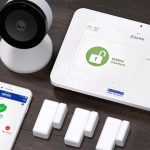I. Introduction

A. Importance of maintaining cybersecurity while working remotely
In an increasingly digital world, remote work has become more prevalent, especially in light of recent global events. However, with this shift from traditional office settings to remote work environments comes an increased risk of cyber threats. It is essential to prioritize cybersecurity measures while working remotely to protect sensitive data, personal information, and maintain the integrity of work systems.
B. Addressing the challenges and risks of remote work
Remote work presents unique challenges and risks to cybersecurity. Factors such as unsecured home networks, the use of personal devices for work purposes, and the potential for phishing attacks can all contribute to vulnerabilities. Understanding and addressing these challenges is crucial for maintaining a secure remote work environment.
II. Maintaining a Secure Remote Work Environment
A. Securing Your Home Network
- Updating and securing your Wi-Fi router
Regularly updating your Wi-Fi router’s firmware is essential to address any security vulnerabilities. Additionally, securing your network by changing the default admin password and enabling strong encryption protocols ensures that unauthorized access is minimized.
- Implementing strong network passwords
Creating unique and strong passwords for your network prevents unauthorized users from accessing your network. Utilize a combination of lowercase and uppercase letters, numbers, and special characters to enhance the complexity of the password.
B. Utilizing Secure Remote Access Tools
- Using a virtual private network (VPN) for secure connections
A VPN creates a secure and encrypted connection between your device and the corporate network, protecting sensitive data from potential eavesdropping or interception. Utilizing a trusted VPN solution while working remotely adds an extra layer of security.
- Employing multi-factor authentication (MFA) for added security
Implementing multi-factor authentication significantly enhances security by requiring additional verification beyond a username and password. This could include biometrics, a security token, or a one-time passcode sent to a registered device, providing an extra safeguard against unauthorized access.
C. Practicing Safe Internet and Email Habits
- Being cautious of phishing scams and suspicious links
Educate yourself about common phishing techniques and exercise caution when clicking on links or opening attachments in emails. Look out for red flags such as spelling errors, suspicious email addresses, and requests for sensitive information.
- Regularly updating and patching software and applications
Software updates often contain patches that address security vulnerabilities. Regularly updating your operating system, antivirus software, and other applications is crucial to protect against known vulnerabilities that cybercriminals may exploit.
By implementing these measures, you can establish a secure remote work environment and minimize the risk of cyber threats. Part II of this article will continue to explore additional strategies to maintain cybersecurity while working remotely, including securing personal devices, protecting against malware, and establishing data protection practices.
III. Protecting Work Devices and Data

A. Using Antivirus and Firewall Software
Ensuring the security of work devices is crucial in maintaining cybersecurity while working from home. Antivirus and firewall software play a significant role in protecting against potential threats and attacks.
- Ensuring antivirus software is up to date
Regularly updating antivirus software is essential to stay protected against the latest malware and viruses. It is recommended to enable automatic updates to ensure that the software is continually updated with the latest threat definitions and security patches.
- Configuring effective firewalls for device protection
Firewalls act as a barrier between your device and external networks, monitoring and filtering incoming and outgoing network traffic. It is important to configure firewalls appropriately to block unauthorized access and protect against potential cyber threats.
B. Implementing Device Security Measures

Implementing device security measures helps to safeguard both the device itself and the data stored within it.
- Enabling device encryption and password protection
Enabling device encryption ensures that any data stored on the device is encoded and cannot be accessed without the encryption key. It is also crucial to set strong, unique passwords for devices to prevent unauthorized access.
- Enforcing automatic screen lock and secure storage practices
Enabling automatic screen lock on devices adds an extra layer of security, preventing unauthorized access when the device is left unattended. Secure storage practices, such as locking physical storage spaces and encrypting external drives or USB devices, further enhance data protection.
C. Backing Up and Safeguarding Data
Backing up important work files and taking measures to safeguard data helps protect against data loss and potential security breaches.
- Regularly backing up important work files
Regularly backing up work files ensures that you have a secure copy of your data in case of accidental deletion, device failure, or a security incident. It is recommended to use encrypted backup solutions and automate the backup process for ease and consistency.
- Utilizing cloud storage or secure external drives for data protection
Cloud storage services offer secure and convenient options for storing and accessing work files remotely. Ensure that the cloud storage provider encrypts data in transit and at rest. Alternatively, using secure external drives with hardware encryption can provide offline backup and additional data protection.
IV. Educating and Training Remote Workers on Cybersecurity Best Practices

Educating and training remote workers on cybersecurity best practices is essential for them to understand the risks and take appropriate measures to protect themselves and the organization’s data.
A. Conducting Cybersecurity Training Sessions
Regular training sessions can provide guidance on securing home networks and devices, empowering remote workers with the knowledge and skills to mitigate risks effectively.
- Providing guidance on securing home networks and devices
Remote workers should be educated on best practices for securing their home networks, such as changing default Wi-Fi passwords, enabling network encryption, and regularly updating router firmware.
- Raising awareness on remote work security risks and prevention strategies
Training should cover common security risks faced while working remotely, such as phishing attacks, social engineering, and unsecured public Wi-Fi. Remote workers should be informed about preventive measures, including identifying suspicious emails, avoiding untrusted websites, and using secure VPNs.
B. Establishing Remote Work Security Policies
Clear and comprehensive remote work security policies help set expectations and provide guidelines for remote workers to follow.
- Outlining acceptable use policies for work devices and networks
Policies should specify how work devices and networks should be used and define acceptable activities, including restrictions on accessing unauthorized websites or downloading potentially harmful software.
- Communicating consequences for non-compliance with security policies
Remote workers should be informed about the consequences of non-compliance with security policies, emphasizing the importance of adhering to the established guidelines to protect both personal and organizational data.
C. Encouraging Regular Communication and Reporting
Creating an open and responsive communication channel ensures that remote workers promptly report any security incidents or suspicious activities.
- Promptly reporting any security incidents or suspicious activities
Remote workers should be encouraged to report any security incidents or suspicious activities they encounter. Reporting incidents promptly allows for timely incident response and mitigates potential damage.
- Promoting a culture of cybersecurity awareness and vigilance
Organizations should foster a culture of cybersecurity awareness and vigilance among remote workers. Regular reminders and updates on emerging threats, best practices, and security tips help keep cybersecurity top of mind.
V. Conclusion
Maintaining cybersecurity while working from home requires a multi-faceted approach. Protecting work devices and data through the use of antivirus and firewall software, implementing device security measures, and regularly backing up and safeguarding data are essential steps. Educating and training remote workers on cybersecurity best practices, establishing remote work security policies, and encouraging regular communication and reporting are equally critical. By implementing these strategies, organizations and remote workers can work together to maintain a secure work environment and protect sensitive data from potential cyber threats.



